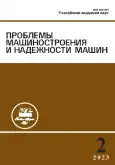Determining the Effect of the Sliding Velocity on Contact Friction under Upsetting with Torsion
- Authors: Petrov P.A.1, Burlakov I.A.1,2, Gladkov Y.A.3, Gartvig A.A.3, Nguyen T.K.1
-
Affiliations:
- Moscow Polytechnic University, Moscow, Russia
- Salyut Machine-Building Production Association, Moscow, Russia
- OOO QuantorForm, Moscow, Russia
- Issue: No 2 (2023)
- Pages: 34-43
- Section: МЕХАНИКА МАШИН
- URL: https://journals.rcsi.science/0235-7119/article/view/137573
- DOI: https://doi.org/10.31857/S0235711923020062
- EDN: https://elibrary.ru/COTVDB
- ID: 137573
Cite item
Full Text
Abstract
The finite element method is a progressive tool for the development and optimization of technological modes of metal forming. However, in order to obtain correct simulation results, it is necessary to set the boundary conditions as accurately as possible. At present, design programs usually use friction laws that do not take into account the sliding velocity. As numerous studies show, the sliding velocity of a deformed metal on the tool surface has a significant influence on the formation process under certain conditions of the flow of the deformed material at the tool–workpiece interface. This article presents the results of experiments and calculations associated with the effect of contact friction on the parameters of upsetting with torsion.
About the authors
P. A. Petrov
Moscow Polytechnic University, Moscow, Russia
Email: petrov_p@mail.ru
Россия, Москва
I. A. Burlakov
Moscow Polytechnic University, Moscow, Russia; Salyut Machine-Building Production Association, Moscow, Russia
Email: petrov_p@mail.ru
Россия, Москва; Россия, Москва
Yu. A. Gladkov
OOO QuantorForm, Moscow, Russia
Email: petrov_p@mail.ru
Россия, Москва
A. A. Gartvig
OOO QuantorForm, Moscow, Russia
Email: petrov_p@mail.ru
Россия, Москва
Toan Khanh Nguyen
Moscow Polytechnic University, Moscow, Russia
Author for correspondence.
Email: petrov_p@mail.ru
Россия, Москва
References
- Зибель Э. Обработка металлов в пластическом состоянии. Теоретическое обоснование процессов ОМД. Пер. с нем. М.: ОНТИ, 1934. 199 с.
- Леванов А.Н., Колмогоров В.Л. и др. Контактное трение в процессах обработки металлов давлением. Изд. “Металлургия”, 1976. 416 с.
- Behrens B.-A., Schafstall H. 2D and 3D simulation of complex multistage forging processes by use of adaptive friction coefficient // J. of Materials Processing Technology. 1998. V. 80 (1). P. 298. https://doi.org/10.1016/S0924-0136(98)00187-3
- Becker P., Jeon H.J., Chang C.C. et al. Modelling the Friction interface in bulk forming processes // In: Neugebauer R (ed) 10. Sä Fachtagung Umformtechnik in Chemnitz October 14–15, 2003, Wissenschaftliche Skripten, Zwickau, S. 179.
- Behrens B.A., Bouguecha ., Hadifi T., Mielke J. Advanced friction modeling for bulk metal forming processes // Prod. Eng. Res. Devel. 2011. V. 5. P. 621. https://doi.org/10.1007/s11740-011-0344-8
- Jain S.C., Bramley A.N. Speed and Frictional Effects in Hot Forging // Proc.Inst.Mech.Eng. 1968. V. 182. № 39. P. 783.
- Davoudi M., Ali Farokhi Nejad, Koloor S.S.R., Petrů M. Investigation of Effective Geometrical Parameters on Wear of Hot Forging Die // J. of Materials Research and Technology. 2021. V. 15. P. 5221.
- Widomski P., Gronostajski Z. Comprehensive Review of Methods for Increasing the Durability of Hot Forging Tools // Procedia Manufacturing. 2020. V. 47. P. 349.
- Lee K.J., Lee M.G. Pressure and sliding velocity dependent surface asperity based friction model: Application to springback simulation // IOP Conf. Ser. Mater. Sci. Eng. 2019. V. 651. https://doi.org/10.1088/1757-899X/651/1/012079
- Cillaurren J., Galdos L., Sanchez M., Zabala A., Sáenz de Argandoña E., Mendiguren J. Contact pressure and sliding velocity ranges in sheet metal forming simulations // ESAFORM. 2021. https://doi.org/10.25518/esaform21.426
- Sigvant M. et al. Friction in sheet metal forming: influence of surface roughness and strain rate on sheet metal forming simulation results // Procedia Manufacturing. 2019. V. 29. P. 512. https://doi.org/10.1016/j.promfg.2019.02.169
- Waanders D., Marangalou J.H., Kott M., Gastebois S., Hol J. Temperature Dependent Friction Modelling: The Influence of Temperature on Product Quality // Procedia Manufacturing. 2020. V. 47. P. 535. https://doi.org/10.1016/j.promfg.2020.04.159
- Behrens B.A., Bouguecha A., Lüken I., Mielke J., Bistron M. Tribology in Hot Forging. In: Comprehensive Materials Processing // Comprehensive Materials Processing. 2014. V. 5. P. 211.
- Петров П.А., Бурлаков И.А., Нгуен Хань Тоан. Перспективы применения гибридных заготовок в машиностроении // Технология металлов. 2021. № 8. С. 10.
- Бурлаков И.А., Петров П.А., Бач Ву Чонг. Изготовление осесимметричных заготовок из титана ВТ1-0 с изотропными свойствами // Технология металлов. 2020. № 10. С. 52.
- Behrens B.-A., Bouguecha A., Hadifi T., Mielke J. Advanced friction modeling for bulk metal forming processes // German Academic Society for Production Engineering (WGP). 2011. № 5. P. 621.
- Neumaier T. Zur Optimierung der Verfahrensauswahl von Kalt-, Halbwarm- und Warmmassivumformverfahren. Dissertation, Universität. Hannover, VDI Verlag Düsseldorf, 2003.
- Alasti M. Modellierung von Reibung und Wärmeübergang in der FEM-Simulation von Warmmassivumformprozessen. Ph.D. Thesis, Leibniz Universität Hannover, 2008.
- Nägele H. Simulation des Herstellungsprozesses präzisionsgeschmiedeter Zahnräder mit der Finite-Elemente Methode. Dissertation, Universität Hannover, VDI Verlag Düsseldorf, 1995.
- Behrens B.-A., Alasti M., Bouguecha A., Hadifi T., Mielke J., Schäfer F. Numerical and experimental investigations on the extension of friction and heat transfer models for an improved simulation of hot forging processes // Int. J. Mater. Form. 2009. V. 2 (Suppl. 1). P. 121.
- Doege E., Bederna C. Analysis of boundary stresses and temperatures in hot massive forming // Production Engineering, Bd. 1996. V. 3 (2). P. 89.
- Bernhardt R. Ein Beitrag zur experimentellen und numerischen Analyse lokaler Kontaktspannungen und Kontakttemperaturen in der Wirkfuge von Gesenkgravuren unter besonderer Beachtung des Randreibungsproblems. Dissertation, TU Freiberg, 1998.
- Хензель А., Шпиттель Т. Расчет энергосиловых параметров в процессах обработки давлением. Справочник. М.: Металлургия, 1982. 360 с.
- Грудев А.И., Зильберг Ю.В., Тилик В.Т. Трение и смазки при обработке металлов давлением. М.: Машиностроение, 1982. 312 с.
- http://qform3d.ru/files_ru/2008_0001_0.pdf (дата обращения 12.09.2021).
Supplementary files




















